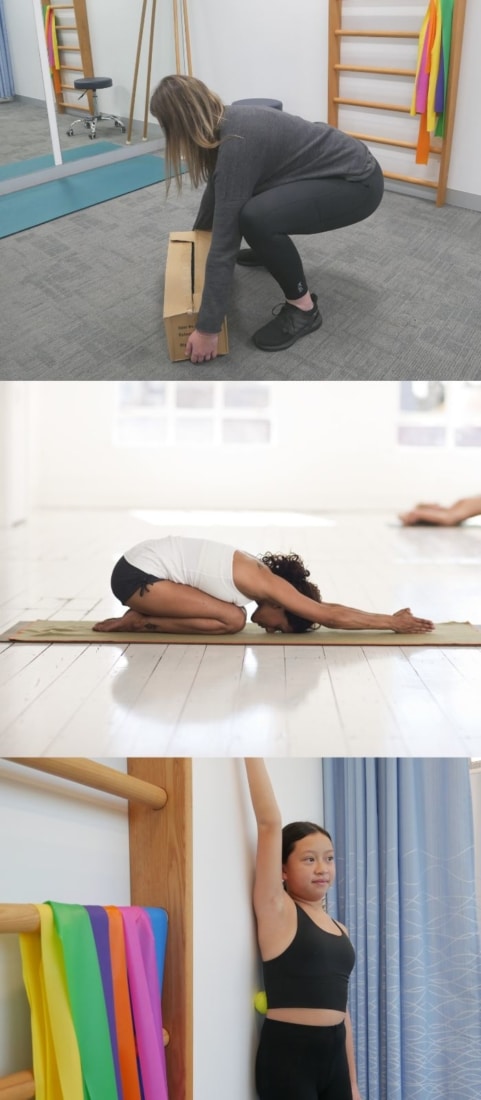By Rebecca Phillips – Exercise Physiologist Team Leader
Scoliosis can cause pain of varying intensity and frequency for each person. It is often thought that pain is more common in adult scoliosis, but there is also evidence of a possible 35-42% prevalence of low back pain in adolescents with idiopathic scoliosis (1).
Below are some basic tips to help day to day with your pain, but ultimately the best advice for you as an individual will be provided by a scoliosis trained health professional.
Keep Active
Being physically active and reducing the amount of time spent in sedentary positions is very important not only for pain management but for your overall health and wellbeing. Being active can involve a variety of physical pursuits, such as walking, Pilates or even a sport.
Any amount of physical activity is better than none, but general guidelines for Australians (2) are as follows:
- Adolescents: At least 1 hour of moderate to vigorous activity involving mainly aerobic activities per day. Vigorous activities should be incorporated at least 3 days per week.
- Adults: Be active on most (preferably all) days, to a weekly total of 2.5 to 5 hours of moderate activity or 1.25 to 2.5 hours of vigorous activity or an equivalent combination of both.
If you currently aren’t active, it is important to gradually increase physical activity levels over time.
Be Aware of Your Posture
When sitting and standing, take note of the position of your spine. Are you collapsed to one side or slouching? Try to lengthen your spine and keep balanced, and avoid leaning to one side as this can aggravate pain after a while.

Avoid Extended Sitting/Extended Standing
Where possible, avoid extended sitting when working, studying or at school. Regular postural changes/breaks (every 20-30 minutes) are very important and can be as simple as standing up, walking to the other side of the room, or stretching, before sitting back down.
A sit to stand desk can also come in handy when wanting to change from seated to standing regularly. It is important to also think about your work place set up and ensure the top third of your screen is at eye level and at arms distance away when sitting with a good posture.
Be Careful When Lifting Heavy Objects
When lifting a heavy object, use the following tips:
- Bend with knees rather than using your lower back to do all the lifting
- Activate your core muscles
- Don’t twist to the side as lifting.
Carrying School Bag/Handbag/Groceries
When carrying heavy bags, ensure you are not carrying all the weight on one side. If possible, distribute the weight evenly between both hands or swap often from one hand to the other
When carrying a backpack, ensure it is over both shoulders and the straps are adjusted well so the weight is distributed evenly.
Light Stretching or Massage
Perform a short sequence of light stretches daily. Especially focussing on elongation and decompression of the spine.
Self-massage (such as using a tennis ball, spiky ball or massage gun) can also help release some of the tighter areas of your back.
Avoid Repetitive One-Sided Movements/Exercises or Movements/Exercises With Excessive Spinal Rotation
Due to the 3D nature of scoliosis, repetitive twisting or one-sided movements can potentially put your spine into an unfavourable position and cause pain. It is best to avoid excessive one-sided movements or excessive twisting of the spine.
Scoliosis Specific Rehabilitation
If pain is persisting, you should engage with a scoliosis specific clinician and/or therapist. They can teach you specific exercises for your spine that will help improve posture, help manage pain and slow progression of your condition. These scoliosis specific exercises, once mastered, can be incorporated into your day-to-day life.
Although the above tips may help manage your pain, it is also important to note, pain you experience may not always be directly related to your scoliosis.
Note: If you are unsure or want further advice on managing your condition, please seek professional treatment from a qualified health practitioner who is specifically trained to assess and treat scoliosis.
References
1 Théroux, J., Stomski, N., Hodgetts, C. J., Ballard, A., Khadra, C., Le May, S., & Labelle, H. (2017). Prevalence of low back pain in adolescents with idiopathic scoliosis: a systematic review. Chiropractic & manual therapies, 25(1), 1-6.
2 Australian Government. Physical activity and exercise guidelines for all Australians https://www.health.gov.au/health-topics/physical-activity-and-exercise/physical-activity-and-exercise-guidelines-for-all-australians, accessed 15 September 2022
